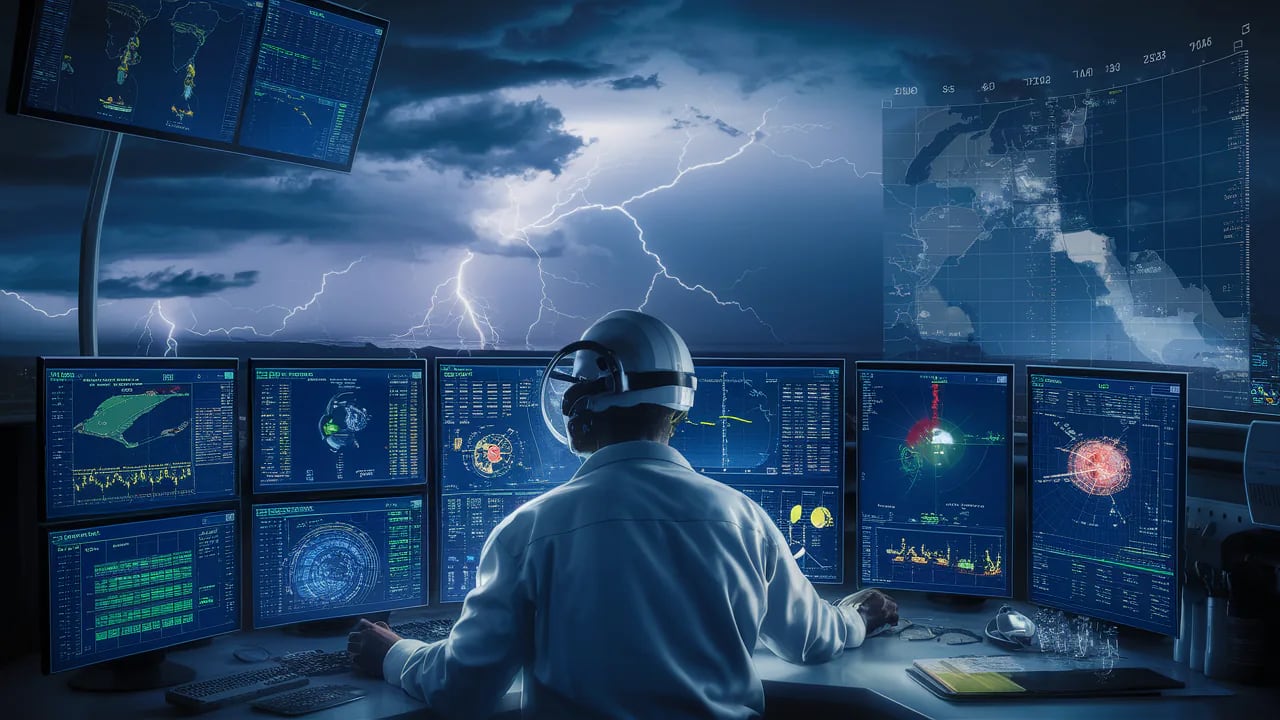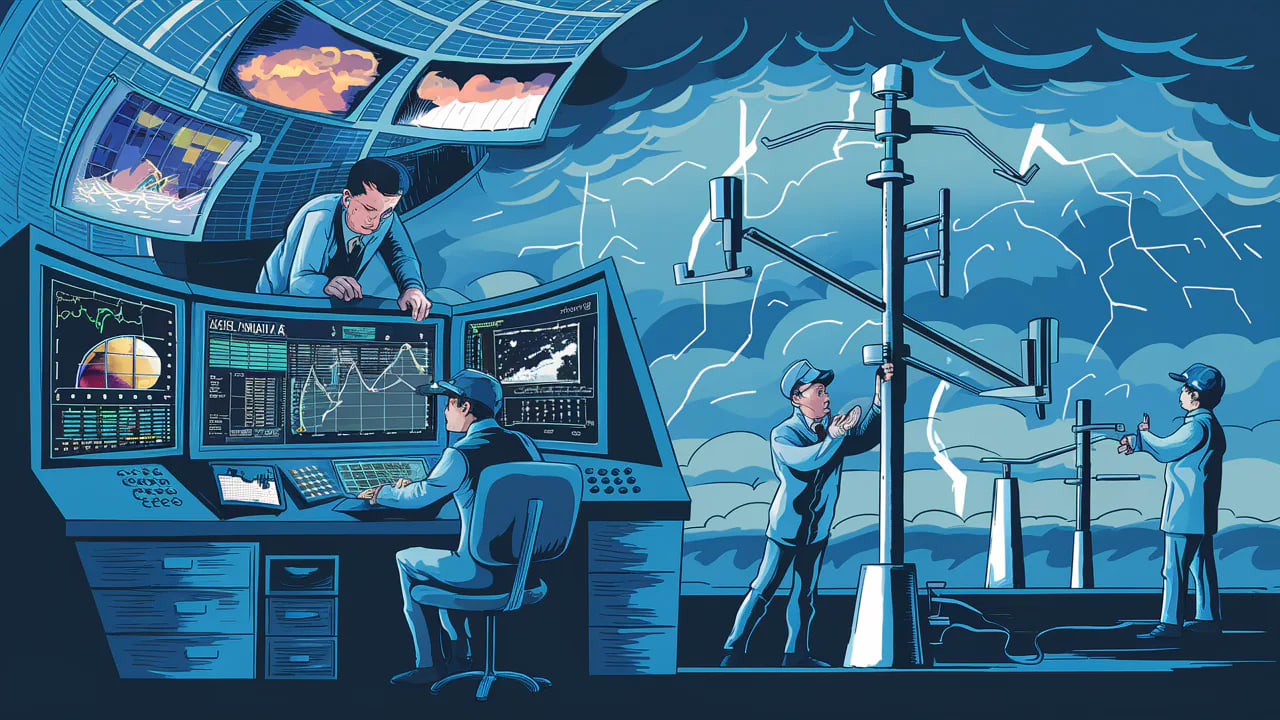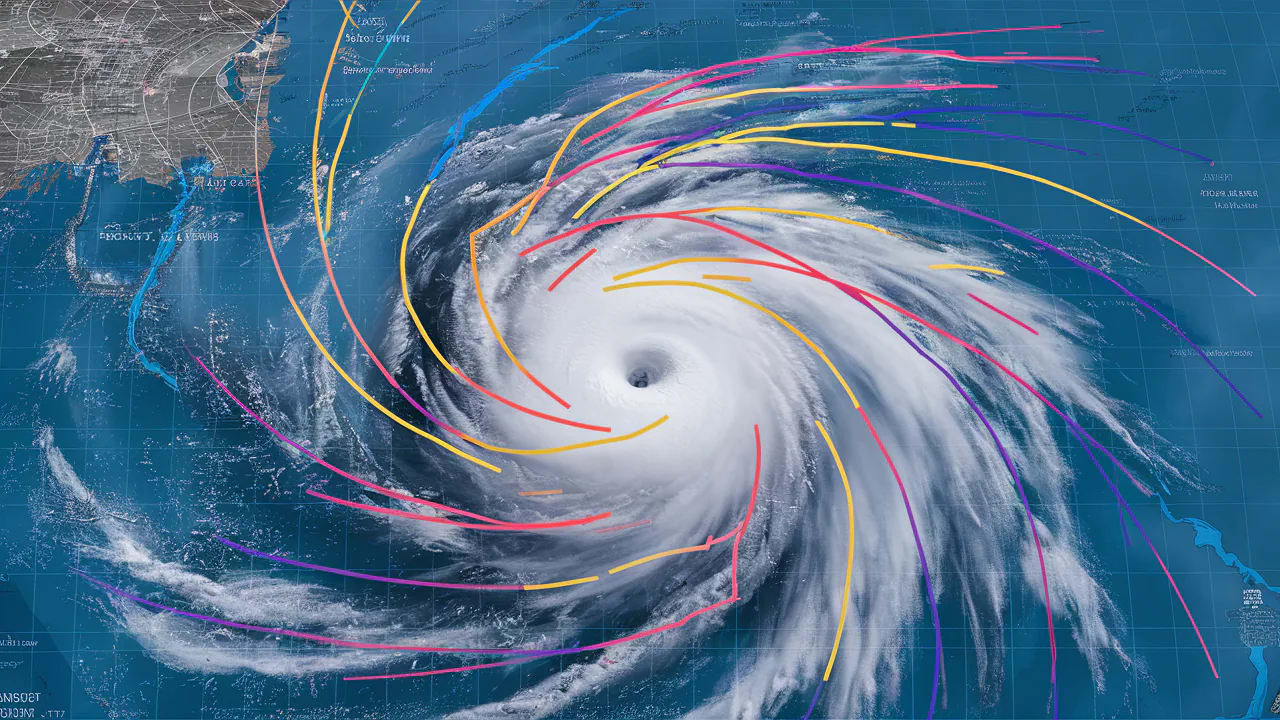How Do Meteorologists Predict the Weather? Unveiling the Science Behind Forecasts
Discover the fascinating methods and tools meteorologists use to predict weather patterns. From advanced technology to time-tested techniques, learn how weather forecasting has evolved and why it sometimes goes wrong.
The Shocking Truth About Weather Prediction
I’ve got a bombshell to drop: meteorologists aren’t wizards, and weather forecasting isn’t magic. Gasp! I know, I know, it’s hard to believe. But here’s the kicker - despite not having crystal balls, we’re getting better at predicting the weather every single day. In fact, a 5-day forecast today is as accurate as a 1-day forecast was in 1980. Mind-blowing, right?
Today, we’re going to dive deep into the world of weather prediction. We’ll explore the cutting-edge technology, the tried-and-true methods, and yes, even the occasional educated guesses that go into forecasting whether you’ll need that umbrella tomorrow.
By the end of this post, you’ll understand:
- The science behind weather prediction
- The tools meteorologists use
- How accurate our forecasts really are
- Why sometimes, despite our best efforts, we still get it wrong
So, buckle up, weather enthusiasts! It’s time to demystify the art and science of meteorology.

The Foundations of Weather Forecasting
Understanding Atmospheric Dynamics
Let’s start with the basics. Weather prediction is all about understanding how the atmosphere behaves. It’s a complex system, constantly in motion, influenced by factors like:
- Temperature
- Air pressure
- Humidity
- Wind patterns
- Ocean currents
- Solar radiation
These elements interact in intricate ways, creating the weather patterns we experience every day. It is the job of a Meteorologist to analyze these interactions and predict their outcomes.
“The atmosphere is a fluid, dynamical system. To understand the weather, we must first understand the principles that govern its behavior.” - Dr. Edward Lorenz, Father of Chaos Theory
If you’re curious about how these atmospheric dynamics play out in real-time, check out our article on what the weather will be like after tomorrow. It’s a fascinating look at how short-term forecasts are made.
The Birth of Modern Meteorology
Modern weather forecasting has come a long way since the days of looking at the sky and guessing. It all started with the invention of the telegraph in the 1840s, which allowed for rapid communication of weather observations across vast distances.
This video provides a fascinating look at the history of weather forecasting and how it has evolved over time.
For those interested in the historical aspects of meteorology, I highly recommend picking up a copy of ”The Weather Machine: A Journey Inside the Forecast” by Andrew Blum. It’s a captivating read that explores the history and future of weather prediction.
The Role of Mathematics in Weather Prediction
At its core, weather forecasting is a mathematical problem. We use complex equations to model the behavior of the atmosphere. These equations take into account:
- The laws of thermodynamics
- Fluid dynamics
- The Coriolis effect
- Radiative transfer
By solving these equations, we can predict how the atmosphere will evolve over time. Of course, it’s not quite that simple in practice, but that’s the fundamental principle behind numerical weather prediction.
Tools of the Trade: How Meteorologists Gather Data
Ground-Based Observations
One of the most important tools in a meteorologist’s arsenal is the network of ground-based weather stations. These stations provide real-time data on:
- Temperature
- Humidity
- Air pressure
- Wind speed and direction
- Precipitation

For weather enthusiasts who want to contribute to meteorological data collection, I recommend setting up a personal weather station. The Ambient Weather WS-2902C Smart Weather Station is an excellent choice for beginners and pros alike.
Weather Balloons: Eyes in the Sky
Weather balloons are another crucial tool for gathering atmospheric data. These balloons carry instruments called radiosondes high into the atmosphere, collecting data on:
- Temperature profiles
- Humidity levels
- Wind patterns at different altitudes
This vertical profile of the atmosphere is essential for understanding its structure and predicting future weather patterns.
Doppler Radar: Seeing Inside Storms
Doppler radar is a game-changer in weather forecasting, especially for short-term predictions and severe weather events. It allows us to:
- Detect precipitation
- Measure wind speeds within storms
- Identify the structure of severe weather systems
Here’s a handy table showing the different types of weather phenomena Doppler radar can detect:
For a more detailed look at how we use radar to predict wind patterns, check out our article on how accurate wind forecasts are.
Satellite Imagery: The Big Picture
Satellites provide a crucial overview of weather systems on a global scale. They offer:
- Visible light images during daylight hours
- Infrared images for cloud-top temperatures
- Water vapor imagery for moisture distribution
These tools allow meteorologists to track large-scale weather patterns and identify developing systems days in advance.
If you’re interested in exploring satellite imagery yourself, the NASA Worldview website is an excellent resource for viewing near real-time satellite data.
The Art and Science of Weather Modeling
Numerical Weather Prediction (NWP)
Now we’re getting to the heart of modern weather forecasting. Numerical Weather Prediction uses powerful supercomputers to solve complex mathematical equations that model the atmosphere’s behavior.
“Numerical weather prediction is like trying to predict the outcome of a chaotic system. It’s challenging, but with the right tools and understanding, we can make increasingly accurate forecasts.” - , Lead Meteorologist at NOAA
The process involves:
- Data Assimilation: Incorporating observational data into the model
- Initial Conditions: Setting up the starting point for the model run
- Model Physics: Applying mathematical equations that represent atmospheric processes
- Boundary Conditions: Defining the limits of the model domain
- Model Integration: Running the simulation forward in time
For a deep dive into how these models work to create detailed forecasts, check out our article on detailed weather forecasts.
Ensemble Forecasting: Embracing Uncertainty
One of the most significant advancements in weather prediction is ensemble forecasting. Instead of running a single model simulation, we run multiple simulations with slightly different initial conditions or model physics.
This approach:
- Provides a range of possible outcomes
- Helps quantify forecast uncertainty
- Improves the overall accuracy of predictions

Ensemble forecasting is particularly useful for predicting the path of hurricanes and other severe weather events. It’s one of the reasons why our 7-day forecasts have become increasingly accurate over the years.
Machine Learning in Weather Prediction
The latest frontier in weather forecasting is the application of machine learning and artificial intelligence. These techniques can:
- Identify patterns in vast amounts of historical weather data
- Improve the accuracy of short-term forecasts
- Help interpret complex model outputs
While AI isn’t replacing traditional forecasting methods, it’s becoming an increasingly valuable tool in the meteorologist’s toolkit.
For those interested in exploring machine learning in meteorology, I recommend the book ”Machine Learning for Weather and Climate Modelling” by Peter Dueben and Peter Bauer.
The Challenges of Weather Prediction
The Butterfly Effect: Chaos in the Atmosphere
Remember Dr. Edward Lorenz, who I mentioned earlier? He discovered something fascinating about weather prediction: tiny changes in initial conditions can lead to vastly different outcomes. This is known as the “butterfly effect.”
“Does the flap of a butterfly’s wings in Brazil set off a tornado in Texas?” - Edward Lorenz
This sensitivity to initial conditions means that:
- Small errors in measurements can compound over time
- Long-range forecasts become increasingly uncertain
- Perfect prediction is theoretically impossible
It’s one of the reasons why weather forecasts are sometimes wrong. Despite our best efforts and advanced technology, the chaotic nature of the atmosphere can sometimes throw us curveballs.
Dealing with Microclimates
Another challenge in weather forecasting is the existence of microclimates - small areas where the weather differs from the surrounding region. These can be caused by:
- Urban heat islands
- Coastal effects
- Mountain ranges
- Large bodies of water
Predicting weather for these areas requires high-resolution models and local knowledge. This is where personal weather stations can be incredibly useful. If you’re in an area with unique microclimates, consider setting up a Davis Instruments Vantage Pro2 Weather Station for highly accurate local readings.
The Future of Weather Forecasting
Improving Resolution and Accuracy
As computing power continues to increase, weather models are becoming more detailed and accurate. We’re moving towards:
- Higher spatial resolution (predicting weather for smaller areas)
- More frequent updates (near real-time forecasting)
- Longer-range forecasts with better accuracy
This improvement in resolution and accuracy is particularly evident in our three-day weather reports, which provide a detailed look at short-term weather patterns.
Integration of New Data Sources
The future of weather forecasting will likely involve integrating new data sources, such as:
- Smartphones: Using pressure sensors in mobile devices for crowd-sourced weather data
- Internet of Things (IoT) devices: Gathering hyperlocal weather information
- Autonomous vehicles: Collecting road-level weather data
For those interested in contributing to crowd-sourced weather data, check out the WeatherFlow Tempest Weather System, which combines personal weather station functionality with smart home integration.
Climate Change and Weather Prediction
As our climate changes, weather patterns are becoming more extreme and less predictable. This presents new challenges for meteorologists, requiring:
- Updated models that account for changing climate conditions
- More emphasis on long-term climate prediction
- Better communication of weather risks and uncertainties
To stay informed about severe weather events, it’s crucial to have access to reliable weather alerts. Our guide on the best weather alert apps can help you choose the right tool for staying safe and prepared.
The Art of Weather Communication
Crafting Clear and Accurate Forecasts
One of the most crucial aspects of meteorology isn’t just predicting the weather - it’s communicating those predictions effectively. As meteorologists, we need to:
- Translate complex scientific data into understandable terms
- Provide context for weather events
- Communicate uncertainty without undermining confidence in the forecast
If you’re interested in improving your own weather communication skills, whether for personal or professional reasons, check out our guide on how to write a weather report. It’s packed with tips on crafting clear, informative weather forecasts.
The Role of Visualization in Weather Forecasting
Visual aids play a crucial role in helping people understand weather forecasts. From radar imagery to forecast models, these tools help us convey complex information quickly and effectively.
Some key visualization tools include:
- Weather maps: Showing temperature, pressure, and precipitation patterns
- Radar loops: Displaying the movement and intensity of precipitation
- Satellite imagery: Providing a big-picture view of weather systems
For those who want to explore weather visualization tools, I recommend the GR2Analyst software. It’s a professional-grade tool that allows you to analyze radar data in incredible detail.
Choosing the Right Weather Resources
With so many weather resources available, it can be challenging to know which ones to trust. Whether you’re planning a weekend camping trip or making crucial business decisions based on weather forecasts, having reliable information is key.
For a comprehensive guide on finding the most accurate and user-friendly weather resources, check out our article on what is the best weather site. We break down the pros and cons of various weather services to help you make an informed choice.
The Tools Meteorologists Use
Ever wondered about the high-tech gadgets and software that meteorologists use to predict the weather? From sophisticated computer models to specialized instruments, the tools of the trade are constantly evolving.
For an in-depth look at the equipment and technology behind weather forecasting, don’t miss our article on what tools do meteorologists use to predict the weather. It’s a fascinating glimpse into the cutting-edge world of meteorological technology.
Conclusion: The Never-Ending Quest for Accuracy
I’m constantly amazed by how far we’ve come in predicting the weather. From simple observations to complex computer models, we’ve made incredible strides in understanding and forecasting atmospheric behavior.
But here’s the truth: we’ll never be perfect. The atmosphere is simply too complex, too chaotic for 100% accurate predictions. And you know what? That’s okay. It’s what makes meteorology such an exciting and challenging field.
So the next time you see a weather forecast, remember the incredible amount of science, technology, and human expertise that goes into it. And if we get it wrong occasionally? Well, that’s just the weather keeping us on our toes!
Whether you’re a weather enthusiast, an outdoor adventurer, or simply someone who wants to stay prepared, understanding the basics of meteorology can enrich your daily life. Keep exploring, keep learning, and most importantly, keep looking up at the sky. After all, the atmosphere is the biggest laboratory in the world, and it’s open 24/7!
Remember, for the most up-to-date forecasts and in-depth weather analysis, be sure to check out our detailed weather forecasts regularly. And if you’re looking to set up your own home weather station, consider the AcuRite Iris (5-in-1) Weather Station. It’s a great way to get hyperlocal weather data right in your backyard!
FAQs
How far in advance can meteorologists accurately predict the weather? Generally, forecasts are most accurate up to about 7-10 days in advance. Beyond that, accuracy decreases significantly due to the chaotic nature of the atmosphere. For more on this, check out our article on how accurate 7-day forecasts are.
Why are weather forecasts sometimes wrong? Weather forecasts can be wrong due to the complexity of atmospheric systems, limitations in data collection, and the inherent uncertainty in predicting chaotic systems. We dive deeper into this topic in our article why weather forecasts are sometimes wrong.
- What's the difference between weather and climate?Weather refers to day-to-day atmospheric conditions, while climate describes long-term average weather patterns in a specific area. Understanding this distinction is crucial for interpreting both short-term forecasts and long-term climate trends.
How do meteorologists predict severe weather like hurricanes and tornadoes? Severe weather prediction involves analyzing atmospheric conditions that are conducive to these events, using specialized radar and satellite data, and running high-resolution models. For real-time severe weather alerts, we recommend using a reliable weather alert app.
Can animals really predict the weather? While some animals may be sensitive to changes in atmospheric pressure or other environmental cues, there’s no scientific evidence that they can accurately predict weather beyond what we can observe ourselves. Stick to reliable weather forecasts for your planning needs!
What tools do meteorologists use to predict the weather? Meteorologists use a variety of tools including weather satellites, radar systems, weather balloons, computer models, and ground-based weather stations. For a detailed look at these tools, check out our article on what tools meteorologists use to predict the weather.
How accurate are wind forecasts? Wind forecasts have improved significantly in recent years, but their accuracy can vary depending on local terrain and atmospheric conditions. Learn more about wind forecast accuracy in our dedicated article on how accurate wind forecasts are.
- What's the best weather website or app to use?The best weather resource depends on your specific needs, but we've compiled a list of top contenders in our article on [what is the best weather site](/blog/what-is-the-best-weather-site). Check it out to find the perfect weather service for you!
Remember, if you’re looking for reliable weather forecasts and engaging weather content, be sure to keep checking back with Optic Weather. We’re here to keep you informed and prepared, no matter what Mother Nature throws your way!
And if you’re interested in diving deeper into meteorology, consider picking up a copy of ”Meteorology Today: An Introduction to Weather, Climate, and the Environment” by C. Donald Ahrens and Robert Henson. It’s an excellent resource for both beginners and weather enthusiasts looking to expand their knowledge.
